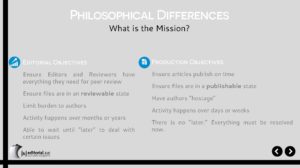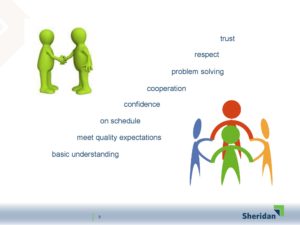MODERATOR:
Heather DiAngelis
Manager, Journals Production
American Society of Civil Engineers
Reston, Virginia
SPEAKERS:
Michael Casp
Director of Business Development and Production Services Coordinator
J&J Editorial
Cary, North Carolina
Nancy Devaux
Process Improvement Manager
Sheridan Journal Services
Waterbury, Vermont
Ruth Isaacson
Managing Editor
Genetics Society of America
Pittsburgh, Pennsylvania
REPORTER:
Becky Rivard
Associate Production Editor
American Mathematical Society
Providence, Rhode Island
The way to build strong relationships is through communication. —Nancy Devaux
The transfer of materials from Editorial to Production can often feel like a one-time handoff, with each side not always clear what is needed. Instead, we should view it as an ongoing communication in which both sides work together toward a common goal. In this session, several speakers discussed the viewpoints of Editorial and Production, shedding some light on what each department needs from each other and how to bridge the gap between the two sides.
First, Ruth Isaacson from the Genetics Society of America (GSA) discussed collaboration and integration with Sheridan, the provider of production services for GSA’s two peer-reviewed journals. As a small publisher, GSA relies on Sheridan for support. Isaacson suggested having QA checklists, giving standardized requests to authors, documenting and evaluating workflows, and above all, having things ready from the start to prevent delays later in the process. Some specific examples include having annual audits of the metadata collection, XML feeds, and documentation, and creating LaTeX and digital art guidelines for authors.
 Next, Michael Casp talked about Production based on his experience at J&J Editorial. He summarized that Editorial is more relationship-based, while Production is more process-based; in both cases, it is important to define responsibilities and review procedures every so often. Casp stressed the importance of communicating changes both ways (Editorial to Production and Production to Editorial). He discussed an example project where Editorial and Production created an Excel spreadsheet to document all of their tasks, which allowed them to see redundancies, gaps, and unnecessary steps. Casp recommended evaluating workflows routinely and defining responsibilities. It is important to remember that we are all on the same team.
Next, Michael Casp talked about Production based on his experience at J&J Editorial. He summarized that Editorial is more relationship-based, while Production is more process-based; in both cases, it is important to define responsibilities and review procedures every so often. Casp stressed the importance of communicating changes both ways (Editorial to Production and Production to Editorial). He discussed an example project where Editorial and Production created an Excel spreadsheet to document all of their tasks, which allowed them to see redundancies, gaps, and unnecessary steps. Casp recommended evaluating workflows routinely and defining responsibilities. It is important to remember that we are all on the same team.
 Finally, Nancy Devaux from Sheridan talked about metaphorically going from shaking hands to holding hands; that is, having a vendor-society relationship built on trust. When Editorial and Production have the same goals, they work better together. Some specific tips she gave include making manuscript submissions as complete as possible before handing them off to Production, keeping schedules on track, sharing clear expectations, and having open discussions whenever changes are being considered. Like the first two speakers, Devaux emphasized communication as the key to successful relationships between Editorial and Production.
Finally, Nancy Devaux from Sheridan talked about metaphorically going from shaking hands to holding hands; that is, having a vendor-society relationship built on trust. When Editorial and Production have the same goals, they work better together. Some specific tips she gave include making manuscript submissions as complete as possible before handing them off to Production, keeping schedules on track, sharing clear expectations, and having open discussions whenever changes are being considered. Like the first two speakers, Devaux emphasized communication as the key to successful relationships between Editorial and Production.
In a brief Q&A, the moderator and speakers again brought up the importance of documentation, checklists, and communication as a two-way street.
